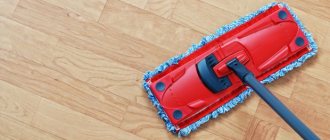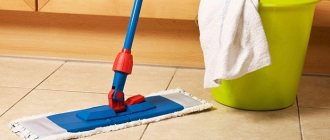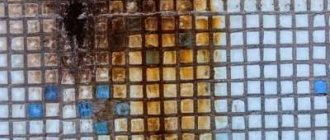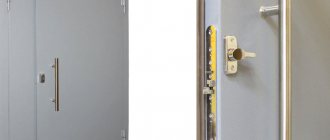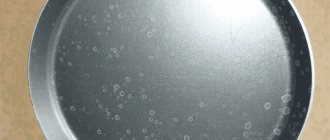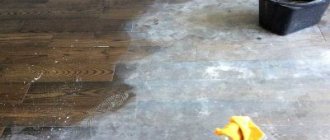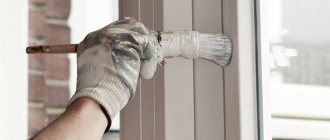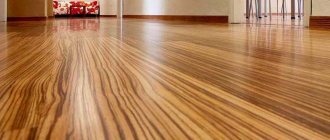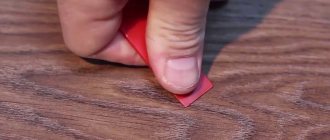During repair work, situations often arise when, quite accidentally, the primer solution or grout gets onto the surrounding surfaces. You can stain tiles, flooring, walls or a metal-plastic window. This problem requires an immediate solution due to the characteristics of the primer. Thanks to its chemical and physical properties, it penetrates to a depth of up to 10 cm and reliably holds materials together. This creates difficulties if it accidentally gets on the windowsills or floor.
Why is primer difficult to remove?
I use primer to fill voids and uneven areas. Among its features is that after it dries completely, it becomes insoluble and resistant to many physical and chemical influences.
For this reason, when working with primer, it is recommended to cover with something all surfaces that may receive splashes or excess mixture. Newspapers, masking tape, cellophane, etc. are suitable for this.
Primer for tiles: why is it needed and how to choose the best one
When people want to lay some surface with tiles, they are interested in the result being extremely smooth and aesthetically pleasing. With each such repair, the question arises - how much primer is needed before laying the tiles? Previously, people often resorted to laying tiles on cement mortar - the wall/floor was treated with ordinary PVA glue. Times have changed, mixtures have become more reliable and of higher quality. Specialized solutions are sold in various construction stores in an exceptional variety. Is it worth resorting to them when finishing the next room, or can you do without them? Or do you need a primer for the floor under the tiles?
About the primer
A primer is a special composition that is usually applied to the floor/wall before the actual process of laying tiles. Its main tasks include improving adhesion between the cladding and the base. There is also an improvement in water-repellent and antiseptic properties. In some cases, when the base is metal, there is protection against corrosion, so the question of whether it is necessary to prime the floor before laying tiles does not even arise.
The mixtures are produced on the basis of various high-quality components that combine film-forming properties. These are drying oils, various resins and other similar components, varying each time. Modern soil mixtures are technologically advanced, diverse, and highly reliable; there are many options for which primer to use before laying tiles.
Should I prime the floor and walls?
This question for experienced craftsmen may seem incorrect, because the role of primer in any modern repair and design work is very great. Do I need to prime the floor before laying tiles? Almost always yes. If the surface is loose, porous or crumbling, this process is mandatory; there is no doubt about the need to treat the floor/wall. A dense concrete base or properties similar to it need not be primed, although it is advisable to do so. There are a number of reasons that make this process important.
She:
- Helps strengthen the surface by playing a binding role. The composition will densely saturate the pores, significantly strengthening its structure, making it less dependent on dynamic/static loads. A primer for walls under tiles in the bathroom reduces the sedimentation of bacteria.
- Reduces the consumption of material used for subsequent processing. This is especially true with ceramics, but is also true with painting and wallpapering.
- Improves grip. The adhesive component will stick to the treated wall/floor better than to the untreated one, so the layout will be of better quality. It is important to consider the combination of the type of soil and the adhesive component used.
Choice
There are several types of primer compositions used in residential areas. They are similar in application, but have different properties and characteristics. Important: try not to use cheap soil. Such soil is easily determined. It is quite easy to identify from the packaging, where there will certainly be a text warning about the potential need for reapplication. If this warning is present, the need for reapplication arises in the vast majority of cases. But it will not be of such quality. This primer for tile adhesive is not optimal. It’s better to overpay a little for soil than to get insufficient quality results.
Main types:
- Acrylic. The most common at present. Most modern products are made on its basis. Quite versatile, can be used on a large number of surfaces. A good option is which primer to treat the walls with before laying the tiles.
- Alkyd. It is considered to be the most durable. It is especially good for glass, tiles, and steel; for plaster and drywall it is a losing option.
- Contains cement, gypsum and lime. Ideal for plastered surfaces, concrete and brick. A good option than priming drywall under the tiles.
The choice depends on your specific needs and the characteristics of the floor/wall you intend to work with.
The compositions may differ in their properties - some are designed for deep penetration into the material being processed, others improve “adhesion” without providing such impregnation. It is necessary to read the instructions for use before working directly with the mixture.
For different materials
When you work with different materials, the requirements for primer compositions may vary greatly, and the technology for working with them may also differ.
- For drywall. Do I need to prime drywall before laying tile? Yes, but with restrictions. In order not to damage the material, it must be thoroughly puttied before applying the primer so that it is not deformed. It is necessary to use waterproof specialized drywall.
- For plywood. Since plywood is porous, it is generally not advisable to lay ceramic tiles on it. Therefore, the primer for plywood under the tiles is also laid with certain restrictions. Very often, plywood is sheathed with various third-party materials or DSP sheets, but in any case, it must first be impregnated with a strengthening soil mixture, produced in the form of a liquid concentrate for absorbent materials.
- For marble, porcelain tiles and so on. The primer for marble is preferable not to strengthen it, but to contain various additives in the form of sand - it will significantly increase adhesion. This will allow tiling to be laid out with better quality and to consolidate the result for a longer time. A similar situation arises with another popular material, when a primer is used for porcelain stoneware.
Methods for cleaning tiles from primer
If the primer gets splashed on the tiles, it is necessary to wash them off as quickly as possible with a soap solution.
If the soil has hardened, you should first try to remove it as follows:
- Dissolve stains on the tiles with a small amount of soil mixture;
- After the primer has dissolved, remove it with a dry cloth;
- Wipe the remaining stain with a damp cloth and then cover with a wet cloth;
- After a couple of hours, remove the cloth and wipe the surface with a damp cloth.
In addition to the proposed method, there are other, no less effective methods.
Mechanical cleaning method
To mechanically remove hardened soil from the surface of the tile, you need to purchase a special scraper with a sharp, replaceable blade from a hardware store.
Then you need to act in the following order:
- Moisten with soapy water and cover the contaminated area with a wet cloth. Leave to soak for at least 6 hours;
- Due to the possibility of damaging the tile surface, the scraper should be handled carefully. Movements should be slow and smooth;
- Sprinkle the remaining stain with baking soda and wipe with a damp sponge;
- After removing the stain, clean the tiles from soda.
This method is not suitable for tiles, which are more vulnerable to scratches.
An expert says: caution is a guarantee of quality
Often, when they need to clean windows, apartment owners or craftsmen buy products such as Hodrupa A or Dopomat. Their effectiveness comes with the risk of damage that may occur if even the slightest trace of these concentrates remains.
A cleaning product such as ATLAS SZOP is in demand among consumers. With its help, all kinds of stains are perfectly removed, including cement, lime, and plaster.
The material is safe and acceptable for treating the following types of surfaces:
- varnished;
- ceramic;
- stone;
- clinker;
- chrome plated;
- from artificial materials.
However, the use of this product on surfaces characterized as acid-labile is strictly prohibited.
Special acids for cleaning tiles
Substances created on the basis of inorganic acids. This method of removing soil is very effective, but can only be used to remove soil from the surface of tiles that are resistant to acids. Most types of tiles under the influence of such substances will lose their appearance and begin to collapse.
- When working with acids, it is important to use personal protective equipment. The room must be well ventilated due to the risk of vapors released by the substance entering the respiratory system. It is necessary to use goggles, a respirator and rubber gloves.
- Before carrying out work, the substance must be diluted with water. Depending on the type of substance, the proportions may differ. Typically, the manufacturer indicates the optimal proportions for mixing the substance with water on the product packaging.
After diluting the solution, it is applied to the hardened soil. During action, the liquid may hiss and bubble, this indicates that the acid is successfully coping with its tasks.
After a certain period of time, the hissing stops, which indicates that the dissolved soil can be washed off. Residues should be cleaned with a baking soda solution.
In some cases, a solution of citric acid will help remove frozen soil. The stain is treated with a sponge soaked in this solution. This method is safer, but may be less effective.
Steam generator
Using a home steam generator is also an option for removing primer from tiles. This method cannot be used to clean windows, as uneven heating will cause the glass to crack. The same problem can occur with glazed tiles. Therefore, to avoid problems, it is better to clean only floor coverings with a steam generator.
The method of cleaning with a steam generator is that a jet of steam is directed at the stain and at the same time the primer is removed with a stiff brush.
Video:
Solvents for cleaning tiles
For tiles that are vulnerable to substances that contain inorganic acids, it is possible to use organic solvents. This method is one of the most effective. Solvents are excellent at destroying soil within a few minutes.
To clean the tiles from the primer, you can use solvents such as:
- Petrol;
- Acetone;
- Turpentine;
- Toluene;
- Ethyl acetate;
- Solvent P-646.
To quickly and completely remove contamination, it is important to adhere to the following procedure:
- Moisten a cloth with the selected solvent and place it over the contaminated area;
- After a few minutes, the fabric can be removed;
- Remove the dissolved mixture with a sponge or cloth;
- After carrying out work, thoroughly wash the treated area with soapy water.
Details
Removing Fresh Primer
During renovations in living rooms, you constantly have to remove dirt and construction debris that appears throughout the entire process. Primer is used for finishing walls. If this composition dries, it is very difficult to wash it off.
To get rid of primer stains, it is recommended to use household chemicals.
Tiles are one of the capricious materials. In addition, it is not resistant to external factors. This coating is easily scratched and cracked. The lifespan of tiles can be extended with regular maintenance. Fresh stains can be easily washed off with plain water or soapy water. To clean a smooth surface, you need to wipe it with a damp sponge. A stain that has not yet dried will be dissolved with water. It will influence the molecules of the primer, while destroying them and the tile will not be damaged.
REFERENCE! This method can help if the primer stain is on the surface for no more than 5-10 minutes. Afterwards it will dry out.
How to clean dried primer
A primer that has already dried is much more difficult to clean. There are several effective ways to remove primer from tiles or windows. These can be folk methods, chemical agents or mechanical effects.
Mechanical method
This method cannot be used on acrylic, glossy tiles.
This is due to the fact that there is a possibility of spoiling the top layer of tiles and paint. You can use this method on a matte surface. To use this method, you need to take a metal scraper or a sharp blade. To clean the coating, wet the primer with soapy water or clean water and leave for 6 hours.
Then you should take a blade or scraper and rub the stains with smooth movements, tilting the blade at an angle of 30-40 degrees. After the base layer has come off, it is necessary to wash off the remaining primer from the tile with a sponge. It must first be impregnated with a product that has an abrasive effect and contains surfactants. For example, it could be baking soda, sodium salt, pumice, metasilicic acid, sodium tripolyphosphate, chalk chips, chlorine, and so on.
It is better to choose products with a soft composition so that there are no scratches on the tiles. The softness is affected by the particle size. Large ones are considered rougher, and small ones are considered softer.
REFERENCE! It is not recommended to rub the tiles vigorously, as marks may remain. Remaining primer can be wiped off with paper or a dry cloth.
How to remove primer from tiles - chemicals
Before you begin the cleansing process, you should protect your hands and wear gloves. If this is not done, you may get a chemical burn. To clean, use acetone, which should be applied to a sponge and wipe the contaminated area with it several times.
The solvent fights stains very effectively, while breaking down the structure of the primer.
The entire processing process takes only 5-7 minutes. The disadvantage of this method is that acetone can leave marks on the tile, remove paint from it, and spoil its appearance.
REFERENCE! There is ATLAS SZOP product on sale. This universal product cleans not only tiles, but also glass, wood, and more.
In addition, experts recommend using turpentine, toluene, and alkali to clean the primer from the tiles. Such products are similar to acetone, but have a milder effect.
Folk remedies
You can also clean the primer using improvised means. If you need to wash dried primer from tiles, you should prepare a solution of water and soda in a 1:1 ratio. Then pop out a sponge in this solution and wipe the contaminated areas. This method cleans the tiles and does not spoil the appearance of the tiles.
Another way is vinegar. Its vapors can burn your lungs or damage the skin of your hands, so you need to use it carefully. Before using it, be sure to wear rubber gloves and a respirator (mask) to avoid unpleasant consequences.
Acetic acid must be diluted with water and stains washed with this solution. The prepared solution must be applied to a rag and applied to the contaminated area, leaving it to act for 10 minutes. Thanks to this, the primer will begin to soak and can be easily wiped off. Then you need to wash off the residue with warm water.
White spirit also helps remove primer. This product is also diluted with water and applied to the dried primer. It is best to spray this solution using a spray bottle. In this case, the solution will be distributed evenly. If the product gets on the wall, it can deteriorate the condition of the paint. After this, the remaining primer is wiped off the surface of the tile using a scraper.
Acetic acid diluted with water breaks down wall finishing material.
REFERENCE! Citric acid can leave marks on the tiles. This product is best used for matte tiles.
Detergents
If none of the previous options for cleaning the tiles from the hardened primer should use strong detergents.
The product is selected taking into account the tile’s resistance to acids and its characteristics. An incorrectly selected substance can contribute to the destruction of the tile structure.
Eye and respiratory protection should be worn when removing primer stains. It is also necessary to use thick, rubber gloves and avoid contact of the substance with bare skin. The room in which the tiles are cleaned should be well ventilated.
How to remove Betonokontakt from clothes?
Re: How to clean concrete contact
? Try water with active oxygen washing powder. It’s good to soak some well-absorbent fabric (batting, for example), cover the area to be cleaned with it, pour some water and powder on top and cover with polyethylene. I think it will go away overnight.
Interesting materials:
How old is Marlowe's fame? How many years does corrugated sheet last? How old are the Sun and Moon? How old is Sonya from War and Peace? How many years does the sun exist? How old is the light from the Bukins? How old is actress Svetlana Nemolyaeva? How old is Yulia Nachalova? How many years have you been studying violin at a music school? How many years have you been studying in SPE?
Sponges
Some types of tiles can be cleaned using special, hard sponges. They are made from special materials that can cope with hardened soil and not damage the tiles.
When working with a hard sponge, it is important to adhere to the following rules:
- Use gloves;
- Wet the sponge with cold water. Do not squeeze water onto contamination;
- Do not use chlorine-containing substances.
Folk remedies for removing primer from floor tiles
You can clean tiles from primers using materials available on the farm.
Baking soda
Baking soda is good at removing primer from tiles.
A softening composition is prepared from it. The powder is diluted with water to form a liquid porridge. It is applied to pre-moistened primer spots. You need to wait 10–15 minutes for an effective action, not allowing the soda paste to dry out. Then the softened primer is wiped off with a hard sponge.
But still it is a slow-acting and weak remedy. Baking soda can only deal with fresh stains. But it is convenient to use as a preparation for preliminary weakening of dried primer.
Before covering dirty spots with wet rags, it is useful to sprinkle them with baking soda powder. This will speed up the softening process and allow you to remove most of the dried material with a scraper.
Vinegar
To effectively clean the primer from tiles, you will need not a table solution of 9%, but vinegar essence containing up to 70% of this substance.
It is poured over dried stains and left to act for 15–20 minutes. It is convenient to moisten large contaminated areas with essence from a spray bottle. Then the primer is scraped off or rubbed off with brushes. The toughest areas will have to be treated several times.
After removing all contaminants, the tiled floor must be rinsed with plenty of water. It is useful to add a little soda - it neutralizes the acid.
When working with vinegar for a long time, you must use respirators. The essence is not particularly harmful to the skin, but its vapors can cause a burn to the lungs.
Polyurethane foam cleaner
The advantage of this method of cleaning tiles from primer is its versatility. This cleaner can be presented in the form of an aerosol or liquid.
In order to remove hardened soil, it is important to use a substance that has a special mark on its label. This means that the cleaner is able to remove the primer.
An aerosol is a more effective way to remove hardened primer. A small amount of aerosol is applied to the contaminated area and then removed with a sponge. The treated area is washed with water.
When working with primer, it is important not to let it come into contact with the tiles.
- It can be covered with paper, tape or cellophane.
- If excess or splashes of primer do get onto the tiles, wash the area with soap and water as quickly as possible.
- The dried mixture can only be removed using all the methods described above for removing primer from the surface of the tile.
Removing stains from various surfaces
All of the above methods for removing primer cannot be universal. You should choose based on the type of surface being cleaned. To make an unmistakable choice, it is better to test the chosen method on a small, inconspicuous area.
Plastic
The primer is relatively easy to wash off from a plastic window sill. You can use almost any method, with the exception of solutions with acid. They can cause serious damage to plastic. It is also not recommended to use hard sponges to avoid scratches.
Even the simplest detergents effectively clean plastic. You can use vinegar essence, alcohol, or any foam cleaner. The product “Silit” performs well. Contaminants are soaked with these products and then removed with a scraper.
